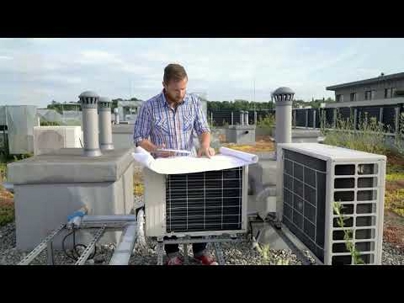A Guide to Keeping Your Cool
The sweet relief of cool air blasting on a scorching summer day. But what happens when your trusty AC unit throws in the towel, leaving you sweltering and desperate? Don’t fret just yet! Before you call in the repair professionals (whose fees can feel scorching themselves), you can tackle a surprising number of minor AC repairs issues yourself.
This guide will equip you with the knowledge and confidence to diagnose common AC problems and sometimes perform simple fixes. Remember, the key is safety first. If you’re uncomfortable with any step or unsure about the cause of the malfunction, don’t hesitate to call a qualified technician. But for the DIY enthusiast yearning to save some money and conquer a household hurdle, keep reading!
Safety Matters: Power Down and Prepare
Before diving into any AC troubleshooting, safety is paramount. Electricity and delicate cooling components are involved, so caution goes a long way. Here’s what to do:
- Turn off the AC unit at the thermostat. Don’t just adjust the temperature; a complete shutoff is crucial.
- Locate your breaker box. Identify the breaker dedicated to your AC unit and switch it off. This ensures no accidental power surges while you work.
- Gather your tools. A screwdriver set, pliers, flashlight, and possibly a shop vac will be handy for cleaning and minor adjustments.
Diagnosing the Problem: Common AC Woes and Potential Solutions
Now that safety is assured, let’s diagnose the culprit behind your AC woes. Here are some frequent AC troubles and potential DIY fixes:
- The AC Unit Won’t Turn On:
- Check the thermostat: Is it set to “cool” and comfortable? If it’s a battery-powered model, ensure the batteries are fresh. Try resetting the thermostat by turning it off for a few minutes and then back on.
- Inspect the circuit breaker: Look for tripped breakers or blown fuses in your breaker box. Reset the tripped breaker (if it clicks back into place) or replace the blown fuse (ensure it’s the correct amperage for your AC unit).
- Verify the power supply: Check the connection to the AC unit itself. A loose plug can sometimes be the culprit.
- The AC Unit Blows Warm Air:
- Clean or replace the air filter: A clogged filter restricts airflow and reduces cooling efficiency. Most filters are easily accessible behind a panel on the indoor unit. Clean them regularly according to the manufacturer’s instructions and replace them when necessary (typically every 1-3 months).
- Clear debris around the outdoor unit: The condenser unit outside expels heat. If it is surrounded by leaves, twigs, or overgrown plants, airflow can be hampered. Keep the area around the unit clear for optimal performance.
- Inspect the condensate drain: Clogged drains can lead to ice buildup on the evaporator coil, preventing proper cooling. Locate the drain (usually a small pipe near the indoor unit) and clear any visible blockages.
- The AC Unit Makes Loud Noises:
- Check for loose parts: Sometimes, loose screws or panels on the outdoor unit can cause rattling noises. Tighten any loose components with a screwdriver.
- Debris in the fan: Inspect the outdoor unit’s fan for twigs or leaves lodged in the blades. Carefully remove any debris to ensure smooth fan operation.
- Low refrigerant levels (caution): While checking refrigerant levels isn’t a DIY project (it requires specialized tools and training), low refrigerant can cause strange noises. Call a qualified technician for proper diagnosis and repair if you suspect this issue.
Beyond the Basics: Advanced DIY Fixes
If you’re comfortable venturing beyond basic troubleshooting, here are a couple of slightly more complex DIY fixes:
- Replacing the Thermostat: Modern thermostats are often modular and relatively easy to replace. Ensure you purchase a compatible model and follow the manufacturer’s instructions for installation.
- Cleaning the Coils: The indoor evaporator and outdoor condenser coils can accumulate dust and dirt over time. While some manufacturers recommend professional cleaning, some DIY-ers tackle this themselves.
- Caution: This can be messy, and improper cleaning can damage the delicate fins on the coils. If you decide to proceed, research the specific cleaning process for your AC unit model and use a soft brush and gentle water spray. Be meticulous and avoid bending the coil fins.
Remember When to Call a Professional
While DIY solutions can address some AC issues, there are situations where calling a professional is the wisest course of action:
- Complex malfunctions: If your troubleshooting efforts haven’t yielded results, or the problem seems intricate, leave it to the experts. Technicians have the expertise to diagnose and fix complex issues efficiently.
- Refrigerant leaks (critical): Refrigerant is an essential component in the cooling process, and leaks pose a health risk. If you suspect a leak (signs include hissing sounds, reduced cooling, or ice buildup on the evaporator coil), immediately turn off your AC unit and call a qualified technician for repair. Refrigerant leaks require special tools and training to recharge the system safely and adequately.
- Replacing significant components: While some may be tempted to tackle replacing major components like the compressor or condenser fan motor, these jobs are best left to professionals. Improper installation or handling of these components can lead to further problems and potentially void your AC unit’s warranty.
Preventative Maintenance: Keeping Your Cool All Season Long
An ounce of prevention is truly worth a pound of cure for AC maintenance. Here are some simple practices to keep your AC unit running smoothly and prevent future problems:
- Regular filter changes: As mentioned earlier, a clean air filter ensures optimal airflow and efficiency. Check and replace your air filter according to the manufacturer’s recommendations (typically every 1-3 months, depending on usage and environment).
- Schedule professional maintenance: It is a wise investment to have a qualified technician perform annual maintenance checks on your AC unit. They can clean components, identify problems early on, and ensure your system operates at peak performance.
- Keep the outdoor unit clear: To maintain proper airflow, regularly remove leaves, twigs, and debris from around the outdoor condenser unit. Avoid planting shrubs or hedges too close to the unit, allowing for adequate air circulation.
- Mind your thermostat settings: While it’s tempting to crank the AC down to arctic levels on a hot day, extreme temperature settings put extra strain on your system. Setting your thermostat to a comfortable temperature (around 78°F) and using ceiling fans for additional air circulation can help maintain comfort without overworking your AC.
Conclusion: The Empowered Homeowner
By familiarizing yourself with basic AC troubleshooting and preventative maintenance, you can become an empowered homeowner, capable of handling minor issues and keeping your cool literally during those sweltering summer months. Remember, safety is paramount. If you’re unsure about a problem or uncomfortable with a repair, don’t hesitate to call a qualified technician. But with the knowledge gleaned from this guide, you’ll be well on your way to tackling common AC woes and keeping your home environment comfortable all season long.
Beyond the Basics: Embracing Sustainable Cooling Practices
While keeping your cool is essential, it’s also important to consider the environmental impact of AC usage. Here are some tips for embracing sustainable cooling practices alongside your newfound DIY prowess:
- Harness the Power of Nature: Take advantage of natural ventilation whenever possible. Open windows and doors in the evening when the outside air is more relaxed. Ceiling fans can significantly enhance air circulation and create a windchill effect, allowing you to raise the thermostat a degree or two without sacrificing comfort. Consider planting shade trees around your home to provide natural cooling during the hottest parts of the day.
- Invest in Smart Technology: Smart thermostats allow you to program your AC unit to adjust temperatures automatically based on your daily routine. This can significantly reduce energy consumption, especially when you sleep away from home. Additionally, some smart thermostats can integrate with weather forecasts, adjusting temperatures based on the predicted outdoor temperature for optimal efficiency.
- Upgrade to Energy-Efficient Models: If your AC unit is nearing the end of its lifespan, consider replacing it with a newer, energy-efficient model. Look for units with high SEER (Seasonal Energy Efficiency Ratio) ratings. While the initial cost might be higher, the long-term savings on your energy bills can be substantial.
- Seal the Deal: Drafty windows and doors can significantly impact your AC unit’s efficiency. Inspect your windows and doors for leaks and cracks, and consider adding weather stripping or caulking to seal any gaps. This simple step can prevent cool air from escaping and warm air from entering, reducing the workload on your AC unit.
The Future of DIY AC Care
The world of DIY AC repair is constantly evolving. With the rise of online resources and instructional videos, even more complex tasks might become feasible for the determined homeowner. However, it’s crucial to maintain a safety-first approach and exercise sound judgment. If a repair seems beyond your skillset or comfort level, never hesitate to call in a professional.
The Takeaway: A Cool and Sustainable Future
Combining DIY knowledge with preventative maintenance and sustainable practices ensures a relaxed and comfortable home environment while minimizing environmental impact. Remember, even small steps can make a big difference. So, empower yourself with knowledge, embrace sustainable solutions, and keep your cool – literally and figuratively – throughout the year.
5 FAQs About AC Repair
How much does a typical AC repair cost?
AC repair costs vary depending on the specific problem and the parts required. However, minor repairs can range from $75 to $150, while more complex issues can reach $500 or more.
Should I fix my AC myself or call a professional?
DIY solutions may be suitable for minor issues like replacing the air filter or cleaning the condensate drain. However, calling a qualified technician is recommended for electrical problems, refrigerant leaks, or complex malfunctions.
How often should I have my AC unit serviced?
Ideally, schedule professional maintenance for your AC unit in St. Petersburg at least once a year, preferably before the peak summer season.
What are some signs that my AC unit needs repair?
Signs like warm air blowing, unusual noises, leaks, or significantly higher electricity bills can indicate AC trouble.
What can I do to improve the efficiency of my AC unit?
Regular filter changes, keeping the outdoor unit clean, and maintaining a comfortable thermostat setting can improve AC efficiency.

